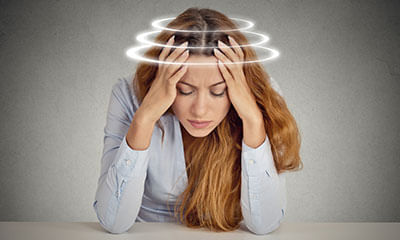Know About Vertigo
Vertigo is the sensation of spinning where a patient feels as if the whole surrounding is rotating and a fear of fall is experienced, getting off balanced or pulled to one particular side is experienced as well.
The feeling of vertigo is very scary and unpleasant leaving the patient terrified and perplexed what actually caused that spinning sensation (vertigo).
Well, vertigo can be caused due to various factors and reasons, although it's more prevalent after the age of 40
Vertigo that often lasts for few seconds is not severe and is often not associated with dizziness, nausea, tinnitus (ringing behind the ear), it can be treated effectively by simple movements taught by the physiotherapist or a doctor.
- This type of vertigo is called bening paroxysmal positional vertigo (bppv) which is very common, and as the name suggests it's not dangerous, and it lasts only for few seconds (paroxysmal) and it's experienced only with specific head movement like turning to left or right or up down.
- This is due to the inner ear rock crystals called canalith made up of calcium gets displaced from its position, which needs to be repositioned by certain vestibular rehabilitation.
- Diagnosis for bppv is confirmed by thorough history taking, examination,
- Otoscope to rule out wax, infections, dix-hallpike test is done by the clinician to confirm bppv.
Vertigo that lasts for few minutes to hour associated with pain, nausea, hearing loss and tinnitus and is not specific to head movement can be severe, it's called meniere's disease, it's a disease if the inner ear where there is accumulation of fluids and disturbed ear pressure.
Vertigo can also be due to inner ear infections or inflammation called as vestibular neuritis or labyrinthitis which may be associated with pain, hearing loss.
Uncommon cause of vertigo are:
Treatment of vertigo:
- Vertigo due to meniere's disease will be treated by medications like diuretics, anti-inflammatory, antibiotics, etc.
- Vertigo due to bppv can be treated by the following procedures:
- Epley's manoeuvre or the canalith repositioning manoeuvre.
- Half somersault exercise
- Brant-daroff exercise
- Semont manoeuvre
- Eye gaze exercise
Bppv once treated rarely comes back, one or couple of sessions of epley's manoeuvre or half somersault may be needed to totally fix it, if it relapses same manoeuvre can be repeated once learnt by a qualified physiotherapist or a ent doctor.
Recurrence of vertigo is once or twice in a year.
Here we will learn how to safely do half somersault manoeuvre as it's one of the most effective and easy to do (do it yourself) technique to immediately stop vertigo due to bppv
Technique of half somersault manoeuvre:
Step by step instructions for right sided bppv --
A. Kneel on the floor or in the middle of a large bed. Tip your head straight upward quickly until you are looking straight up at the ceiling. This may cause dizziness briefly.
B. Next place your head on the floor upside down, as if you are about to do a somersault. Tuck the chin so that your head touches the floor near the back of the head rather than near the forehead. This position may cause a burst of vertigo. Without moving, wait until any vertigo ends. The vertigo means the particles are moving in the proper direction. Tapping firmly on the skull with your fingertips just behind the right ear can help move the particles along.
C. Slowly turn your head to face your right elbow. Try to center the right elbow in your field of view. You will keep your head turned to the right through the rest of the maneuver. Again, wait for any vertigo to end before moving to the next step.
D. Keeping your head turned to the right and viewing your right elbow, quickly raise your head to shoulder level. Your head should be positioned at about 45-degree angle to the floor throughout this move. Vertigo is normal during this part of the procedure. Wait for the vertigo to end or count to 15 before continuing.
E. Raise your head to the upright position quickly, keeping it about halfway turned toward the right shoulder. Some additional vertigo may occur. After the vertigo subsides, slowly sit upright.
Rest for 15 minutes. After the rest, quickly tip your head up and down. If no dizziness occurs do not repeat the maneuver. If you still feel some dizziness when making that movement, repeat the maneuver. You may also repeat the maneuver if you have another vertigo spell in the future.
Additional instructions:
- Always wait at least 15 minutes between maneuver to allow particles to settle.
- Sleep propped up on 2 or 3 pillows for two nights following maneuver.
- Sleep only on your left side for a week after the maneuver (put a pillow behind you to keep you from rolling over in the night).



+1.svg)
